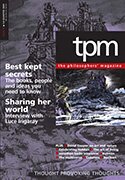Ron Novy on why we can’t get under the skin of the caped crusader
 Imagine yourself doing whatever Batman does. Would the experience let you know what it’s like to be Batman? Like a lot of kids with the impulse to leap off furniture and spring through doorways, it only took a bath towel pinned around my neck for me to become the Caped Crusader. Sliding across the kitchen linoleum in my pre-nonflammable footie pajamas, I would provide my own soundtrack with the “nah-na nah-na, nah-na nah-na” theme from the 1960s TV show. At that time, I had no doubt that this was a thoroughgoing Batman experience. As it turns out, I was wrong.
Imagine yourself doing whatever Batman does. Would the experience let you know what it’s like to be Batman? Like a lot of kids with the impulse to leap off furniture and spring through doorways, it only took a bath towel pinned around my neck for me to become the Caped Crusader. Sliding across the kitchen linoleum in my pre-nonflammable footie pajamas, I would provide my own soundtrack with the “nah-na nah-na, nah-na nah-na” theme from the 1960s TV show. At that time, I had no doubt that this was a thoroughgoing Batman experience. As it turns out, I was wrong.
In fact, in order for you or anyone other than Batman to know what it’s like to be Batman, you would need to meet at least two conditions: first, you’d need to be as extraordinarily and psychologically damaged as Batman; second, you’d need to have the same experiences and relations to the world as Batman. The only person who comes close to meeting these conditions is the Joker, and even he doesn’t really know what it’s like to be Batman.
Acting like Batman is quite different from actually knowing what it’s like to be Batman. At best, one can “do as Batman does” – brood in the Batcave, admire the long curve of Catwoman’s calf, or tumble down an alley with some of the Joker’s henchmen. Insofar as your actions mirror those of Batman, with a little practice you could do a pretty fair job of behaving as Batman behaves – but this is not the same as knowing what it’s like for Batman to be Batman. To actually know Batman’s experience of such events – that is, to know what it’s like to be Batman – would require knowledge of Batman’s subjective experiences, knowledge to which (it seems) Batman alone has access.
Each of us finds ourselves limited in this same way regarding the subjective experiences of other conscious beings. So, to clarify an old chestnut, when it is claimed that we can’t understand another’s perspective until we have “walked a mile in her shoes”, this doesn’t mean we can come to know what that experience is actually like for that other person, but rather that we can imagine what that experience may be. Nevertheless, this can often deliver the desired understanding, not because we have actually experienced what it’s like to be her, but rather because we are imaginative and empathetic creatures. We can understand one another because people are alike in many ways: we share common experiences, physiology, and so on.
Given that Batman and the Joker were transformed into the creatures they are now under similar rare and horrific conditions, and given that each has attempted to make sense of the world through this shared and fractured lens, I suspect that if anyone other than Batman could know what it’s like to be Batman, that person would be the Joker.
Batman and the Joker were each born in violence, each the product of an ordinary person who was fundamentally transformed on “one bad day”. Their strange intimacy is the madness shared by two angels of death debating conditions necessary for human freedom.
Batman’s story is well known. Young Bruce Wayne witnesses the senseless murder of his parents by a small-time crook. Despite their cooperation, the mugger loses his nerve and shoots the pair. In that instant, Bruce loses not only his parents, but also his illusory understanding of the world. Suddenly, he realises that not all people are decent and that not everyone cares about his happiness; that some problems can’t be resolved by a generous dip into a bottomless bank account; that visceral hate and explosive violence can be liberating; and that the polished world of Wayne Enterprises is built upon a sunless foundation in which suffering and want are not isolated occurrences.
The Joker’s “one bad day” is less well known: An unremarkable chemical engineer has quit his job and failed at his dream of being a stand-up comedian; he loses his pregnant wife in a fluke accident, is forced into a bungled robbery of his former employer, and plummets into a tank of noxious waste while fleeing the police. It is a baptism from which emerges the Joker: green hair, pallid skin, and insane.
Recognising Batman’s similar experience of destruction and rebirth, the Joker is stunned by Batman’s commitment to fight chaos. “When I saw what a black, awful joke the world was, I went crazy as a coot!” he told Batman. “I admit it! Why can’t you? … It’s all a joke! Everything anybody ever valued or struggled for – it’s all a monstrous, demented gag!”
For both Batman and the Joker, violence overthrew a coherent picture of the world without installing a replacement; they share this realisation and are bound together in an effort to make sense of it. Like violators of the tabernacle or visitors in Oz, each has glimpsed behind the curtain of appearances.
This experience of becoming disillusioned and of catching a glimpse of secret knowledge binds Batman and the Joker, though neither is quite sure what was revealed about how the world “really is”. While they have different hopes regarding the nature of that world behind the appearances, they have only one another with whom to commiserate regarding the terrifying recognition that this world – our world of cops and robbers, joy-buzzers and cemeteries – for them doesn’t exist.
Even acknowledging that this phenomenal world is one of appearance, Batman and the Joker, at least in regard to one another, behave as if the world matters. Batman has ended more than a few story arcs by returning the killer clown to Arkham Asylum – something one might not expect given the Joker’s body count and the numerous opportunities Batman has had to offer Gotham City “a more permanent solution” to its recurring Joker problem. Yet as he reveals to Mr. Zsasz, the serial killer who commemorates each kill with a tally mark carved into his own body, Batman needs to continue his relationship with those he fights. It is in their struggle that he gains recognition as something apart from the world of appearance: “Do you want to know what power is? Real power? It’s not ending a life, it’s saving it. It’s looking in someone’s eyes and seeing that spark of recognition, that instant they realise something they’ll never forget.”
The Joker, too, recognises this reciprocal relationship with Batman, a relationship without which each one would cease to be who he now is. As he explains it to Batman, “You can’t kill me without becoming like me. I can’t kill you without losing the only human being who can keep up with me. Isn’t that ironic?!” For the Joker, behind the façade that dissolved in the tank of chemical slop, there is only chaos. While literally nonsensical, chaos is also wholly liberating – in chaos, there is no fear to restrain you and no conditions that might limit your choices. According to his therapist at Arkham Asylum, the Joker “creates himself each day. He sees himself as the Lord of Misrule and the world as a theatre of the absurd.”
For Batman, this world beneath the appearances is one of order, though not a predetermined order one might read about in that copy of Metaphysics for Dummies you picked up from the discount table at your local bookstore. Rather, it is a moral order that must be wrestled into existence by recognising the effect of one’s choices on our shared future.
Yet, for all of the shared events, nonsense, chaos, tragedies, and victories that Batman and the Joker have experienced, they do not – and cannot – know what it’s like to be in one another’s shoes. Batman’s phenomenal experience and situation in the world is wholly his own; the Joker’s phenomenal experience and situation in the world is wholly his own; and each is unable to experience the world in any other way. Yet, both Batman and the Joker are committed to the absurd yet serious task of seeing the world as it truly is. Each seems to grasp that this requires a sort of testing, and thus the other’s participation, despite that other person’s literal inability to experience the world in the same way.
With this in mind, consider the joke the Clown Prince tells Batman at the end of The Killing Joke as they wait for the police to arrive. Two inmates decide that they should escape the lunatic asylum together. They scramble to the top of the asylum’s wall and gaze upon the world spread before them in the moonlight. Just one hop to a nearby roof and they’re free – out of the asylum and into the world. The first jumps across and then turns to see his partner frozen on the far side. As the Joker puts it, “His friend daredn’t make the leap, y’see. Y’see, he’s afraid of falling.” The inmates stand there, freedom waiting in any direction if only the second man would leap over what his companion sees as a little gap but which he perceives as a deadly abyss. The first man proposes a solution. “Hey! I have my flashlight with me. I’ll shine it across the gap between the buildings. You can walk along the beam and join me.”
“What do you think I am, crazy?” says the second guy. “You’d turn it off when I was half way across!”
As it begins to rain and the police lights appear in the distance, the Joker and Batman laugh. Their snickers build to doubled-over roars, overcome by the absurdity of their shared secret. The first unable to know what it is like to be Batman; the second unable to know what it is like to be the Joker.
Ron Novy is a lecturer in philosophy & the humanities in the University College at the University of Central Arkansas
Extracted and edited from Batman and Philosophy: The Dark Knight of the Soul, edited by Mark D. White and Robert Arp, part of of the Blackwell Philosophy and Popular Culture series.
 Email This Post
Email This Post 



Interestingly, the Joker has successfully impersonated Batman at least once, though possibly more often. That particular act was good enough to let the Joker sneak into the Justice League satellite. Anyone able to dig up the reference?
I really enjoyed this read. Thanks.
Perhaps I could, perhaps though some fancy inter-brain-connection, have access to Batman’s subjective knowledge and experiences. Still I would never know what it was like to be Batman, because to do so would require me to not mediate those Batman subjective experiences with my own memory and identity.
To truly experience what it was like to be Batman I could no longer be me.
Through osmosis or possibly transmographication, it may be that the two are one, in an alien sense, religion aside, but with significant spirituality involved, but I would not like to speculate for fear of offending. Amusing and thought-provoking missive. Ta much.